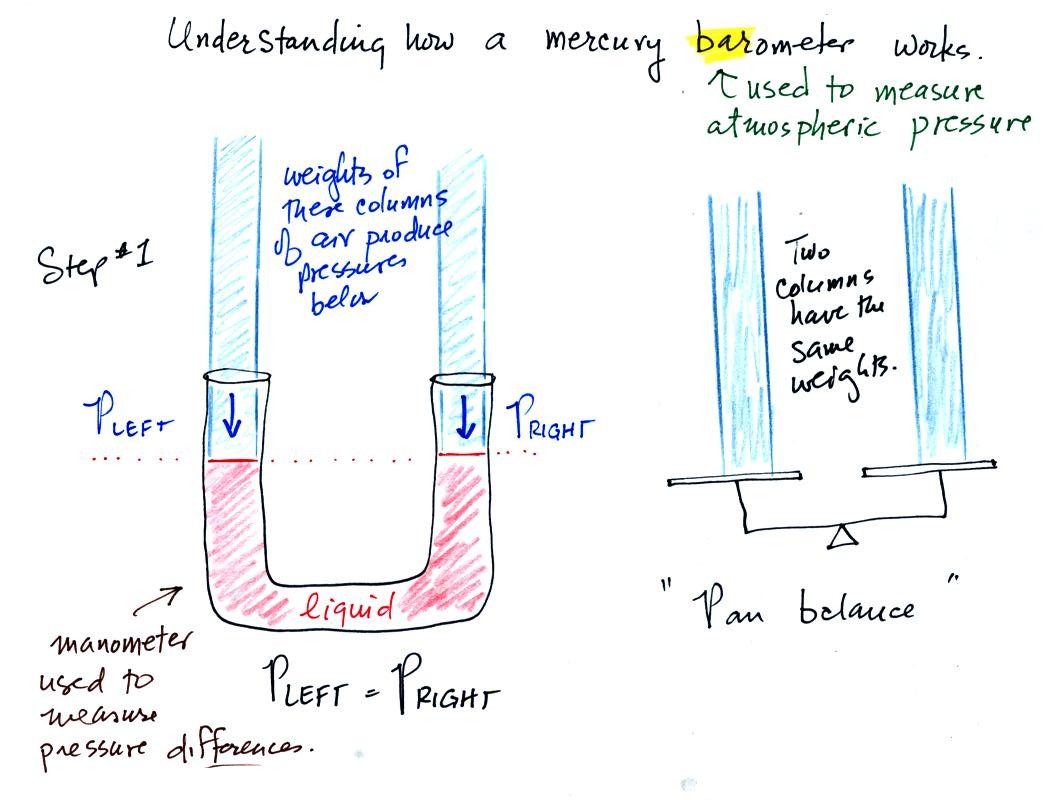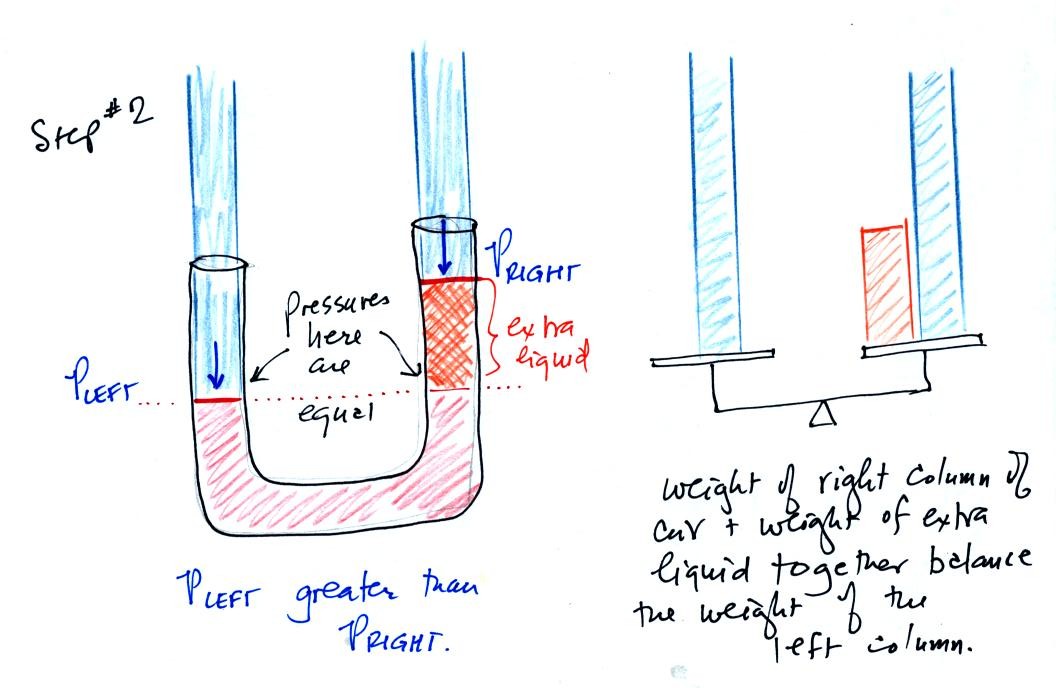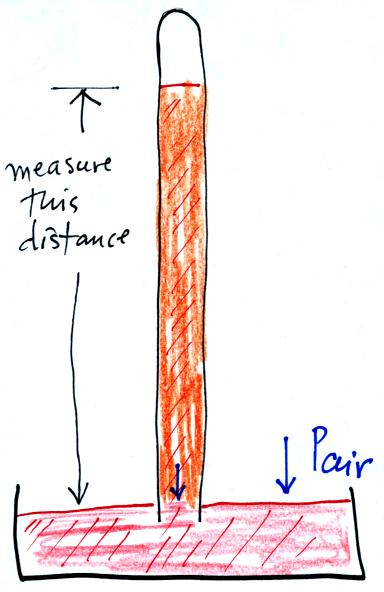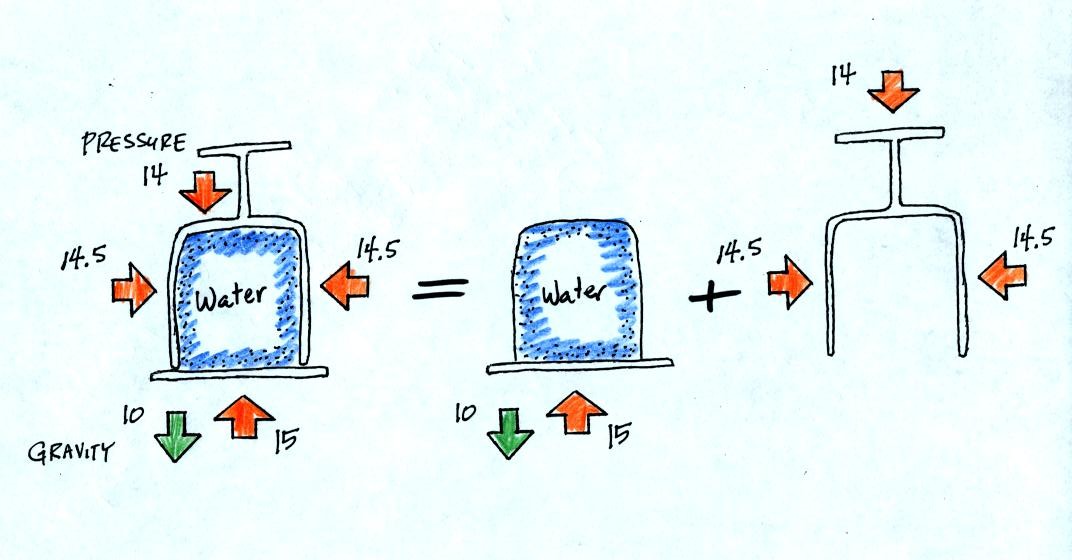Wednesday Jan. 24, 2007
The Practice Quiz is Wednesday next week. The Practice Quiz Study Guide is now available
online. The packet of old quizzes and an old final exam from a
previous semester of this course are now available for purchase ($2.50).

As you move upward from the ground pressure decreases by 100
mb in both
layers in the figure above. Both layers contain the same amount
of air (if you refer
back to the previous figure you will find the a 100 mb drop when you go
from sea level to Tucson - 10% of the
air in the atmosphere lies between sea level and 3000 ft altitude in
Tucson). That air is found in a smaller volume in
the figure at left (the layer is thinner). This means the air at
left is denser than the air at right. The drop in air pressure in
the layer at left occurs in a shorter vertical distance than in the air
layer at right. That is a more rapid rate of pressure decrease
with distance than in the layer at right.
The rate of pressure decrease
with altitude is higher in the dense air at left than in the lower
density air at right.
This is a fairly subtle but important concept. We will use it
next week (or the week after) when we learn about troughs and ridges on
upper level weather charts. We will also use use this concept
when we try to understand the intensification of hurricanes later in
the semester.
You'll
find most of the following on p. 29 in the photocopied class notes.

A manometer can be used to measure pressure
difference. The
manometer is just a u-shaped tube usually made of glass so that you can
see the liquid that is inside. The liquid can slosh back and
forth just like the pans on a balance can move up and down. A
manometer really behaves just like a pan balance.
In this picture the fact that the liquid levels are the same in the
right and left tubes means P1 and P2 are the same (note you really
don't know what P1 and P2 are, just that they are equal).

Now the situation is a little different, the liquid levels
are no
longer equal. The red shaded portion of the liquid is the
balance that we had in the previous picture. The pressures at the
levels of the two blue arrows are equal (the red shaded fluid is the
balance). P2 is not able by itself to balance P1, P2 is lower
than
P1. P1 plus the pressure produced by the column of extra liquid
on the right balances P1. The height of the column of extra
liquid provides a measure of the difference between P1 and P2.

We have changed the manometer by lengthening the right tube
and sealing
it off at the top. Air pressure can't get into the right tube any
more. The balance is again shaded in orange at the bottom of the
barometer.
Pair is equal to the pressure produced by the column of liquid on
the right. If Pair changes, the height of the column will
change. You now a way of
measuring and monitoring the atmospheric pressure.
Barometers like this are usually filled with mercury. Mercury is
a liquid. You need a liquid that can slosh back and forth in
response to changes in air pressure. Mercury is also dense which
means the barometer won't need to be as tall as if you used something
like water. A water barometer would need to be over 30 feet
tall. With mercury you will need only a 30 inch tall column to
balance the weight of the atmosphere at sea level under normal
conditions (remember the 30 inches of mercury pressure units mentioned
earlier). Mercury also has a low rate of
evaporation so you don't have much mercury gas at the top of the right
tube.

Finally here is a more conventional barometer design.
The bowl of
mercury is usually covered in such a way that it can sense changes in
pressure but not evaporate and fill the room with poisonous mercury
vapor.

Air pressure is a force that pushes downward, upward, and
sideways.
The bottom person in the people pyramid below must push upward with
enough
force to support the other people. The air
pressure in the four tires on your automobile push down on the road
(that's something you would feel if the car ran over your foot) and
push upward
with enough force to keep the 1000 or 2000 pound vehicle off the
road.

The person on the bottom of the "people pyramid" must
support
the weight of all the people above. People in the middle don't
have to support as much weight.
Next we did a demonstration that reveals the existence of an upward
point pressure force. The demonstration is described on p. 35 in
the photocopied class notes.

We will look at what is going on in a little more detail. First
the case of a water balloon:

The figure at left shows air pressure (red arrows)
pushing on all
the
sides of the balloon. Because pressure decreases with increasing
altitude, the pressure pushing downward on the top of the balloon is a
little weaker (strength=14) than the pressure pushing upward at the
bottom of the
balloon (strength=15). The two sideways forces cancel each other
out. The
total effect of the pressure is a weak upward force (shown on the right
figure, you might have heard this called a bouyant force).
Gravity exerts a downward force on the water
balloon. In the figure at right you can see that the gravity
force (strength=10) is stronger than the upward pressure difference
force (strength=1). The
balloon falls as a result.
In the demonstration a wine glass is filled with water. A small
plastic lid is used to cover the wine glass. You can then turn
the glass upside down without the water falling out.

All the same forces are shown again in the left most
figure.
In
the right two figures we separate this into two parts. First
the water inside the glass isn't feeling the downward and sideways
pressure forces (because they're pushing on the glass). Gravity
still pulls downward on the water but the upward pressure force is able
to overcome the downward pull of gravity. The upward pointing
pressure force is used to overcome gravity not to cancel out the
downward pointing pressure force.
The demonstration was repeated using a 4 Liter flash (more than a
gallon of water, more than 8 pounds of water). The upward
pressure force was still able to keep the water in the flask (much of
the weight of the water is pushing against the sides of the flask which
the instructor was supporting with his arms).









